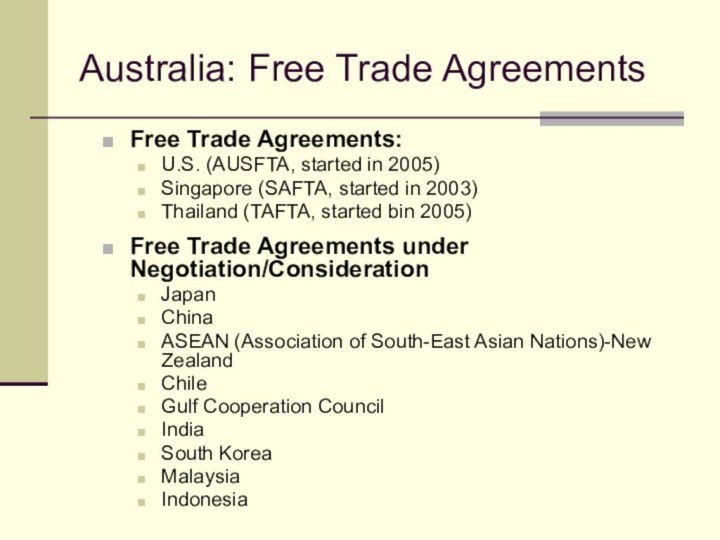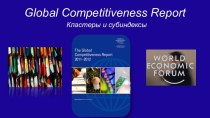Слайд 2
Australian Economy
Prosperous, Western-style market economy
World Bank classification:
Low-income
economies
53 countries (e.g., Haiti)
Lower-middle income economies
55 countries (e.g., Guatemala)
Upper-middle
income economies
41 countries (e.g., Mexico)
High-income economies
60 countries (e.g., Australia)
Слайд 3
Composition of GDP (%)
Australia U.S.
Agriculture 3.7
0.9
Industry 25.6 20.6
Services
70.7 78.5
Слайд 4
Composition of Exports (%)
Australia U.S.
Minerals and
Metals 60 ?
Rural Goods 17
9
Manufactured Goods 18 82
Слайд 5
Australian Economy
Major economic reforms starting in the 1980s
First
reform: Labor Party’s floating of AUD in 1983
Free-trade agreements
and reduction of trade barriers
Financial sector deregulation, including 1992 access for foreign bank branches
Rationalization and reduction of trade unions
Restructuring of centralized system of industrial relations and labor bargaining
Better integration of individual state economies into federal system
Improvement and standardization of national infrastructure
Privatization (e.g., Australian Wheat Board)
Слайд 6
AUSTRALIA:
Annual Changes in GDP and CPI
GDP
CPI
Слайд 7
Australian Economy
Current concerns
Large current account deficit
Absence of export-oriented
manufacturing industry
Real estate bubble
High levels of net foreign debt
owed by the private sector
Pressure on environment
Слайд 8
POPULATION
Australia 20 million
United States 294
million
China 1,300 million
India 1,073 million
World 6,390 million
Слайд 9
World Population Density
Population (bottom) and Internet (top) densities
Слайд 10
Australian Population Density
0-100
Слайд 11
Annual Population Growth,
Australia 1.16% per year
U.S. 1.12% per year
Слайд 12
Net Immigration Rate,
Australia 0.58% of total population
U.S. 0.40% of
total population
Слайд 13
Foreign-Born Population,
circa
Australia 23%
U.S. 11%
Слайд 14
Gross Domestic Product,
(billion U.S. dollars, PPP)
Australia
700
U.S. 12,400
Слайд 15
World Gross Domestic Product (1999)
Слайд 16
Earth’s Satellite Picture at Night
Слайд 17
Per Capita GDP and GNP,
(U.S. dollars, PPP)
Australia
34,200 (GDP) 32,900 (GNP)
U.S. 41,800 (GDP) 41,700 (GNP)
Слайд 18
Per Capita GNI and NNI,
2005 (U.S. dollars, PPP)
Australia
32,900 (GNI) 27,700 (NNI)
U.S. 41,700 (GNI) 36,400 (NNI)
Слайд 20
Australian Dollar (AUD, A$, AU$)
Currency of the Commonwealth
of Australia
Includes Australia, Christmas Island, Cocos (Keeling) Islands, and
Norfolk Island, as well as the independent Pacific Island states of Kiribati, Nauru and Tuvalu.
Introduced in 1966
Not only replacing the Australian pound (distinct from the pound sterling since 1929) but also introducing a decimal system.
Sixth-most-traded currency in world foreign exchange markets (behind U.S. dollar, euro, yen, pound sterling, and swiss franc)
AUD accounts for 4–5% of worldwide foreign exchange transactions.
Слайд 21
Monetary Conversion Rates
AUD per U.S. dollar
Слайд 22
Exchange Rate
AUD per U.S. dollar
Слайд 23
Real Annual GDP Growth,
Australia 3.8%
U.S. 3.2%
Слайд 24
Annual Inflation (GDP Deflator),
1992-2005
Australia 2.4%
U.S. 2.1%
Слайд 25
Long-Term Interest Rates,
Australia 6.6%
U.S. 5.5%
Слайд 26
Unemployment Rates,
Australia 6.9%
U.S. 5.1%
Слайд 27
Government Net Borrowing-Lending as % of GDP,
Australia
1.6%
U.S. -4.4%
Слайд 28
Government Debt as % of GDP
Australia 1.6%
U.S. -4.4%
Слайд 29
Taxes on Income and Profits as % of
GDP,
Australia 18.2%
U.S. 11.1%
Слайд 30
Taxes on Goods and Services as % of
GDP,
Australia 8.9%
U.S. 4.7%
Слайд 31
Household Expenditures in Recreation and Culture as %
of GDP,
Australia 7.1%
U.S. 6.4%
Слайд 32
Infant Mortality,
Australia 4.7 deaths per 1000 live
births
U.S. 6.8 deaths per 1000 live births
Слайд 33
Life Expectancy at Birth, 2004
Australia 80.6 years
U.S. 77.5 years
Слайд 34
Prison Population Rate,
Australia 120 per 100,000 people
U.S. 725
per 100,000 people
Слайд 35
GINI Index (higher income inequality, higher index)
Australia 35
U.S. 45
Слайд 36
Annual Water Consumption per Capita,
Australia 930 m3
U.S.
1,739 m3
Слайд 37
Trade-to-GDP Ratio,
Australia 21%
U.S. 13%
Слайд 38
AUSTRALIA
Trade in Goods and Services
Слайд 39
AUSTRALIA: Exports
STM: Simply-transformed manufactures
ETM: Elaborately-transformed manufactures
Слайд 41
AUSTRALIA: Imports
STM: Simply-transformed manufactures
ETM: Elaborately-transformed manufactures
Слайд 43
Destinations of Exports (%)
AUSTRALIA
Japan (20%)
China (12%)
South Korea (8%)
U.S.
(6%)
India (6%)
New Zealand (6%)
U.S.
Canada (22%)
Mexico (13%)
Japan (6%)
China (5%)
U.K. (4%)
Germany
(4%)
Слайд 44
Origins of Imports (%)
AUSTRALIA
China (14%)
U.S. (14%)
Japan (10%)
Singapore (6%)
Germany
(5%)
U.S.
Canada (16%)
China (16%)
Mexico (10%)
Japan (8%)
Germany (5%)
Слайд 45
Australia: Free Trade Agreements
Free Trade Agreements:
U.S. (AUSFTA, started
in 2005)
Singapore (SAFTA, started in 2003)
Thailand (TAFTA, started bin
2005)
Free Trade Agreements under Negotiation/Consideration
Japan
China
ASEAN (Association of South-East Asian Nations)-New Zealand
Chile
Gulf Cooperation Council
India
South Korea
Malaysia
Indonesia
Слайд 46
AUSTRALIA
Balance of Trade and Current Account
Слайд 47
AUSTRALIA
Major Ag Policy Developments
Reduction of trade-distorting support schemes
for producers
Major reduction in support to dairy producers
Implementation of
drought-support measures
Emphasis in policies encouraging drought-preparedness amongst farmers
More economic-oriented policies for water usage
Expansion and strengthening of natural resource and environmental policies, mainly aimed at preventing soil degradation
Streamlining of sanitary measures for imports
Слайд 48
Producer Support Estimates
as % of Gross Farm Receipts
Слайд 49
AUSTRALIA
Farm Support Schemes
Tax arrangements and risk-management tools to
manage income fluctuations
Excise tax rebates on diesel used by
farmers
Accelerated depreciation for land and water-conservation investments
Publicly funded research and development
Assistance for exceptional situations (e.g., droughts and floods)
Import tariffs on certain types of cheese, unprocessed tobacco, and processed fruits and vegetables
Слайд 50
Australia Wheat Board
Near-monopoly for Australian wheat exports
AWB currently
exports 96% of Australian wheat
Created in 1939
Served as model
for Canadian Wheat Board
Government-controlled until 1999
Privatized in 1999 (owned by active wheat growers)
Publicly traded in Australian Stock Exchange since 2001
















































































